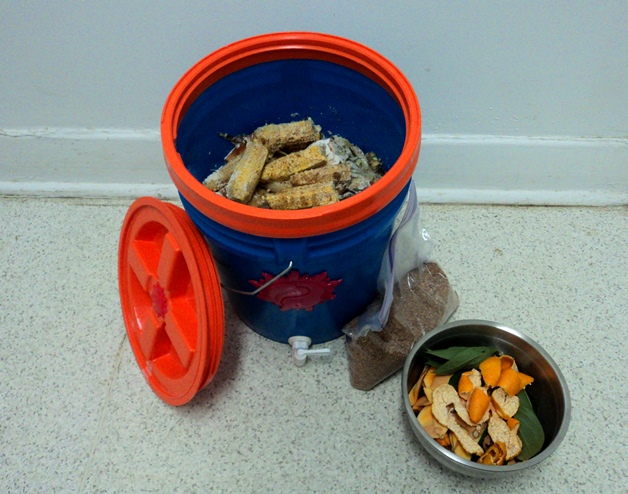
Bokashi composting (indoor method)
courtesy of the Saskatchewan Waste Reduction Council
Bokashi buckets layer food waste - including meat, bones, and dairy - into a sealed bucket to ferment. The fermented waste then needs to be mixed into a large tub of soil indoors, stirred into a compost pile, or buried in garden soil outdoors to finish decomposing.
For a quick introduction, watch the SWRC's 1-minute video Bokashi Composting in 60 Seconds
- Make sure your bokashi bucket has either a false bottom or 2-3" of dry sawdust in the bottom to absorb any extra liquid from the fermentation process.
- Add food waste (vegetable and fruit scraps, grain-based products, coffee and tea waste, eggshells, meat, bones, dairy, or cooked food) to the bucket in 1" layers. If possible, chop bulky food waste into 2-3" pieces before adding so they can be packed more tightly in the pail.
- Sprinkle 1-2 tablespoons (a small handful) of bokashi bran over the food waste.
- If you have more food waste to add, repeat the 1" layering and sprinkling of bran.
- Place a round item that fits fairly snugly into the bucket, such as a plate, on top of the food waste and press down firmly. This helps expel as much air as possible. Optional: Place a rock or brick on top of the plate to compress the food waste further.
- Keep the lid of the bucket closed tightly whenever you are not adding food waste.
- If your style of bokashi bucket has a spigot in the bottom for excess liquid, check if there is liquid built up every few days. The tapped liquid makes a good drain cleaner.
- White mold should start to grow on the contents within a few days. This mold is not dangerous and means the process is working. The food waste will also develop a sour, beery smell that should only be detectable when the bucket is opened.
- When the bucket is full, close it tightly and set it aside to ferment for a minimum of 2 weeks. If it is more convenient, it can also be stored this way for several months. Begin a different bokashi bucket at this time.
- Finished buckets eventually need to be emptied into a large tub of soil indoors, stirred into a compost pile, or buried in garden soil outdoors.
- If you are using the indoor method, put several inches of garden soil into the bottom of a large tub. (Do not use sterile potting soil for this.) Pour in the contents of your bucket and blend it thoroughly with this soil. Cover with several more inches of soil and leave the tub for 2 weeks. After 2 weeks, you can begin checking how decomposition is going. After 6 weeks, the fermented waste should be totally dissolved.
- If you are using an outdoor compost pile, simply pour in the contents of your bucket and stir them in to the previous material.
- If you are using an outdoor garden space, dig a hole or trench at least a few inches away from the nearest plants. Pour in the contents of your bucket and blend it with the soil. Cover with several more inches of soil. This area will be temporarily too acidic for planting, but safe after 6-8 weeks.
What composting style do they fit?
Bokashi buckets require a some knowledge but little work to maintain, so they work well for both hands-off and hands-on composters. They work especially well for composters that have occasional access to an outdoor garden or compost space to empty the finished buckets.
What space does it need?
Bokashi buckets need indoor space. The finished buckets also need to be emptied a few times a year into a large tub of soil indoors, an outdoor garden, or an outdoor compost pile.
How do they work?
Bokashi buckets use a mix of lactobacteria, phytobacteria, and yeast (added using inoculated bran) to ferment food waste in an anaerobic environment. While this doesn't change the appearance of the food waste significantly, it alters it dramatically at a cellular level. The food waste is now much easier for regular decomposition microbes to break down. When the fermented waste is added to a tub of soil, outdoor compost, or buried in a garden, decomposition microbes from the environment rapidly colonize the material and dissolve it completely in 2-6 weeks.
Can you use it all year?
Bokashi buckets are an indoor system and can be used all year. During the winter finished buckets can be mixed into a large tub of soil indoors, stored up until spring, or dumped into an outdoor compost bin.
Where can you get inoculated bran?
Inoculated bran can be purchased from several different suppliers in Canada, including:
- Early’s Farm and Garden Centre, 2615 Lorne Ave, Saskatoon
- Vermikashi (based in Regina; contact vermikashi@gmail.com)
- Mortise & Tenon, 2415 11th Ave, Regina.
- Bokashi Living
- bokashicycle

